| |
Cairo is known as the City of 1,000
Minarets because of its many mosques. Many of these
mosques are open to visitors, and in fact, Cairo has an
ongoing program for the restoration of ancient mosques, a
few of which ranks as some of the oldest to be found in
the world. Certainly some are the grandest to be found
anywhere. Many visitors to Egypt, who arrive with even
a meager interest in this architecture and a slightly open
mind, and particularly those with a creativity streak,
will be awestruck by their beauty and design. Yet, and
unfortunately, many western visitors may completely bypass
these wonders of a very different civilization. For many
others who do wonder into an ancient mosque or two, their
lack of knowledge regarding this art form will often
result in a short, cursory examination lacking substance.
Mosques, and Islamic architecture in general,
unlike western architecture, varies more between
different geographical regions then it does between
historical ages. Scholars tell us that this is at
least due in part to the rapid initial spread of
Islam, as opposed to that of Christianity, which was
suppressed during its first several hundred years.
Christianity had the opportunity to develop more
common architectural styles in its formative years,
while Islam spread through a vast territory quickly
where the use of local building material and ideas by
local craftsman and architects created very
distinguished regional variants.
|
|
|
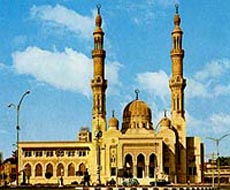 |
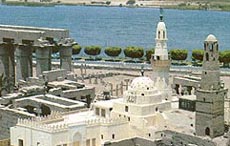 |
|
Left: The Salah el Din Mosque on Roda combines an
Ottoman ground plan with Mamluk decorations |
|
| |
|
Yet, because Egypt has seen many influences from any
number of different ruling empires, including Abbasid,
Fatimid, Ayyubid Mamluk and Ottoman and others, and
because Cairo specifically is a city of the world,
Egypt offers a fair overview of mosque styles.
Furthermore, its mosques date from the earliest
periods of Islam up to and of course, including modern
varieties.
Some mosques in Egypt, and particularly Cairo, are
actually complexes that include a number of other
structures that may, or may not be found attached to
other mosques. For example, many mosques include an
Islamic school facility, called a madrasa. Others may
have mausoleums and tombs, and even hospitals (maristan),
along with other structures within the complex.
Other mosques may be located in strange places. There
is a mosque (Abu Al-Haggag Mosque), which creates a
rather strange appearance inside the Temple of Luxor
in Upper Egypt, and in the Sinai, a Fatimid mosque is
incorporated into the famous St. Catherine's
monastery.
Egypt has some very notable, as well as important
mosques, some of which may be visited while others are
not open to touristic visits. While most of the
tourist mosques are to be found in Islamic Cairo, the
oldest of them all, the Amr Ibn El-Aas Mosque, is
located in Coptic (Christian, or Old Cairo) and may be
visited, while the Al-Azhar Mosque, the location of
the World's oldest University and one of the most
influential mosques in Islam, is not a tourist
facility.
About Mosques - Their Concept
Although Christians, Jews and Muslims worship the same
god and have their roots within the same religious
history, the concept of a mosque is very different then
that of a Christian church, for example. While modern,
moderate Islamic states such as Egypt function in a
somewhat modified manner, traditionally there is no
separation between religion and state as is typical in the
Christian world, and in fact, the leader of a mosque in
ancient times was very often also the governor or
political ruler. Within this context, mosques
theoretically are both a place of worship as well as a
political forum. While modern political decisions in Egypt
appear somewhat secular, Islamic leaders very often make
political statements, and undoubtedly, their voice is
needed and welcomed by politicians in order to
substantiate their agendas. Mosque leaders, called iman,
not only lead the congregation in prayer, but very often
also discuss matters of state during the Friday prayer
sessions.
Basic components of a Mosque
The Demarcated Space
Prayer is an essential element of Islam, and the
demarcated space allows a space for congregational prayer.
In formal mosques, the demarcated space is almost always
partially roofed, and partly open to the sky. The covered
prayer hall, or sanctuary (haram) usually varies relative
to the size of the open courtyard (sahn). The courtyard is
most often surrounded on three of its sides by colonnades,
or arcades (riwags), with the fourth side opening into the
covered sanctuary. The prayer hall, which is normally
rectangular or square, may take the form of a hypostyle
hall with its roof supported by a number of evenly spaced
columns. In this design, a system of horizontal beams
known as architraves, or alternatively, a system of arches
support the ceiling. In other designs, the roof may
consist of a single large dome on pendentives (one of the
greatest contributions made by Islam to architecture), or
instead, by one or more smaller domes.
The size and proportion of the covered verses the open
courtyard is dependent both on the size of the
congregation and the climate of the region where the
mosque is located. Obviously, in wetter or colder climates
a smaller open courtyard would be required then in, for
example, a city such as Cairo, where rain is scares and
the climate is usually moderate even in winter.
|
|
|
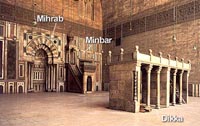 |
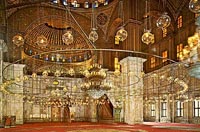 |
|
|
Left: Prayer
Hall in the Mohammed Ali Mosque, Cairo |
| |
|
The Qibla Wall and the Mihrab
Right: Mihrab of the Sultan Hassan
Mosque
Mosques throughout the world have a standard
orientation. Within the prayer hall, one wall must face
Mecca, the direction in which Muslims should face in order
to pray. This wall is called the qibla wall, and at its
midpoint is a niche or recess that constitutes the central
and most decorated feature of any mosque, known as the
mihrab. The mihrab basically takes the layout of a Roman
niche, with a semicircular recess arched at the top. It
should be noted that the mihrab is not considered to be a
sacred element of the mosque. Rather, it prescribes the
the sacred direction for prayer to Mecca. When in prayer,
Muslims will form row upon row, each parallel to, and
facing the qibla wall.
The Minbar
The minbar is basically the Islamic equivalent to the
pulpit and is always located to the right of the mihrab.
It takes the form of a staircase leading to a small
platform from which the iman leads prayers and also
delivers the oration (khutba), which occurs on Fridays and
may be part sermon and partly a political message. An iman
may be defined as any adult male who leads a congregation
in prayer. In actuality, the iman usually leads the
prayers not from the platform at the top of the minbar,
but from a step below. This is because the platform itself
is symbolically reserved for the Prophet Muhammed,
himself.
Minbar displayed in the Islamic Museum, Cairo
The minbar may vary in height depending on the
congregation's size, as it is simply to provide an
elevated platform meant to allow the congregation to more
easily hear the iman's words. Depending on the size of the
congregation, the minbar may have only a few steps, or may
be truly monumental, though in very small mosques, there
may be no minbar at all. The minbar may, or may not have
handrails leading up the staircase to the platform. The
small platform is often covered with an attractive shape,
such as a cupola style roof.
Minbar in the Muhammed Ali Mosque, Cairo
As a side note, in historical times, the minbar was used
for the coronation, or inauguration for a new caliph, a
political ruler.
|
|
|
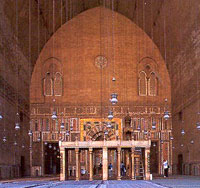 |
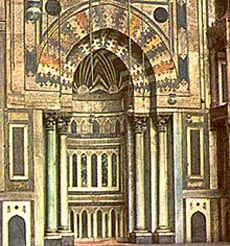 |
|
Qibla Wall of
the Sultan Hassan Mosque, Cairo |
|
| |
|
The Dikka
The dikka is a raised platform form which the respondents
(qadi) repeat the ritual postures of the iman and speak
the responses so that the stages of prayer may be
transmitted to larger congregations. For those familiar
with the Greek Orthodox Church, the qadi is not unlike the
role of the cantor and chorus. Though the dikka is often
located within the covered sanctuary, depending on the
climate and the size of the congregation, it may be
located in the open courtyard. Regardless, it is aligned
with the position of the mihrab.
The dikka usually takes the form of a wooden, "single
story platform" accessible from its own staircase.
|
|
|
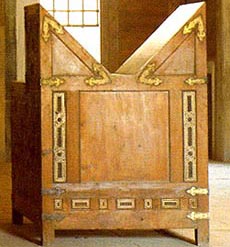 |
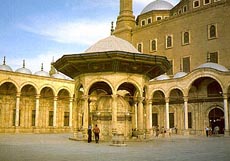 |
|
|
Fountain in the
Courtyard of the Mohammed Ali Mosque, Cairo |
| |
|
The Kursi
The kusi is basically a bookstand or lectern on which the
Muslim holy book, the Qur'an, is placed. The kusi is
generally set next to the dikka, so that the qadi man read
and recite form the Qur'an.
The Maqsura
In ancient times, when many of the most interesting
mosques were constructed, rulers or governors, often
referred to as caliphs, were in danger of assassination.
In the earliest era of Islam, this individual was also the
iman of a principle mosque. Originally, the maqsura
consisted of a raised platform with protective wooden
screens built to safeguard the ruler's life. In this early
age of Islam, the governor's place (dar al-imara) was
often constructed adjacent to the qibla wall providing him
immediate access to the mihrab area of the mosque and the
maqsura. The maqsura was often very elaborate, providing a
suitable environment for the prestige of the ruling
governor. In some cases, a separate enclosure was also
provided for princes, or local rulers, such as the open
iwans of mosques in Central Asia.
The Pool
Water for ablutions before prayer is provided in most
large mosques, though these days its function is sometimes
purely decorative. If the pool is decorative in nature,
then another water supply, often in a room near the shoe
storage area, is available for ablutions. The pool may, or
may not have a fountain, though when used for ablutions,
it is more likely to have a fountain to allow a number of
worshippers to wash simultaneously under running water.
The pool is usually located at, or near the center of the
open courtyard.
Ablution Fountain in the mosque of Sultan Hassan,
Cairo
If the pool incorporates a fountain, this structure is
very often of a creative and inventive design, surmounted
by domed, or small pavilion like roofs.
The Minaret
The towering minarets are the most visible part of a
mosque, particularly form any distance, and we have a
strong identification of mosques with minarets, even
though they were not universally incorporated into their
construction until the 14th and 15th centuries. Used to
call worshippers to prayer (adhan) by the muezzin, during
the lifetime of the Prophet Muhammed, the adham was issued
from the roof of his house in Medina. Hence, while many
elements of a mosque mimic elements within the Prophet's
Medina home, the minaret does not.
|
|
|
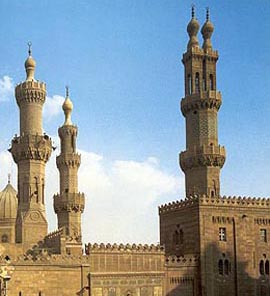 |
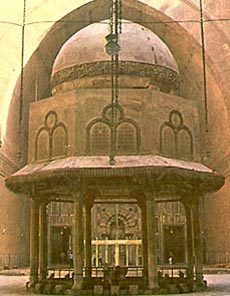 |
|
Minaret of the
Muhammed Ali Mosque, Cairo |
|
| |
|
Scholars believe that as an architectural form, the
minaret may be based on one, or a combination of
Zoroastrain symbolic fire towers, Roman watch towers,
coastal lighthouses or even church towers. Regardless,
other then serving as perhaps a local landmark, the
minaret provides a means to ensure that the voice of the
muezzin can be heard at a maximum distance.
Today, many calls to prayer may be issued through
loudspeakers. Hence, in modern times, the function of the
minaret has often become more symbolic, and may even be
excluded from modern structures. Another interesting
modern facet of minarets is that many, including those of
ancient origin, may have elaborate lighting.
Obviously, only one minaret was actually needed, which
most public mosques incorporate, However, under the
Ottoman and Mughal empires, twin minarets signifying royal
patronage were frequently built. Sometimes, more minarets
were added, with four not being completely uncommon, and
at Mecca, there are seven.
The Portal
Mosques are almost always surrounded by high walls. In the
ancient world the protection of ones family, particularly
women and daughters, rested more squarely on the shoulders
of individuals rather than a public security force.
Therefore, one general nature of early Muslim architecture
that has survived even into the modern era is the
concealment of building interiors from outside view.
Enclosure walls, sometimes functioning for the purpose of
fortifications, are and were common.
Right: Monumental portal to the mosque of Barquq, Cairo
With regard to mosques, this barrier became to symbolize
the threshold between the chaos and bustle of the outside
world, and the tranquil atmosphere within. Entry to this
more subdued atmosphere is gained through the portal, a
gateway to the mosque that takes on a powerful
psychological importance. Hence, these elements are often
monumental and incorporate ornate decorations intended to
pay tribute to God's presence, and really, to also
emphasize the generosity of the mosque's principle patron.
Yet, another reason for these grand entrances is that
Islamic theology requires that the outside of a mosque,
remain somewhat plain and simple because the building
itself may not seduce by means of ornamental frills.
However, in major mosques where possible, including the
minaret, dome and portal, allowances were often made so
that the patronage of the mosque's major contributor,
often the caliph, could be appropriately commemorated.
Geometric Designs
Judaism, Christianity and Islam all spring from a
common religious well. They are like limbs of a tree, that
originate from the same trunk, and we can find examples,
sometimes even somewhat obscure, that mirror each other. A
regular occurrence among these religions is that one
branch may take a somewhat extreme view of some specific
ancient doctrine that another takes more lightly. Such is
the case with graven images. The Islamic faith takes the
ban of graven images (particularly regarding humans and
god in a religious setting), also found in the common
Christian Old Testament, much more seriously then do
Christians in general. Yet there are fundamental Christian
sects that likewise reject almost all graven images,
carrying this to an extreme not even remotely mirrored in
the Muslim world, excluding even television, pictures and
paintings from their personal lives.
|
|
|
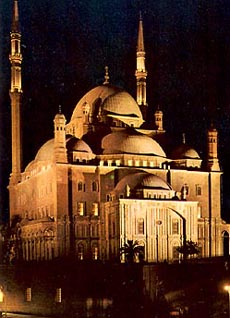 |
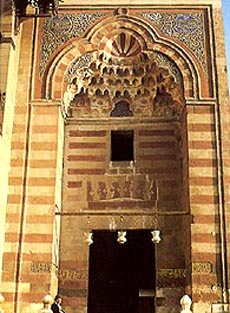 |
|
|
Minaret of the
Muhammed Ali Mosque, Cairo |
| |
|
However, the real point in this discussion is that,
particularly in a religious setting, the Islamic faith and
the Christian faith specifically deviated considerably
regarding graven images, and thus, religious decorations
within places of worship took two very different paths.
While the early Christians developed all manner of
religious icons of Christ, his apostles, saints and
others, the Islamic faith substituted geometric designs to
decorate their sacred places. Both divergences evolved in
sophistication, and so often the decorations within a
mosque will seem very alien to a modern Christian visitor,
though a more thorough examination of ancient Christian
churches will reveal some similar elements. This is rather
interesting, because modern analysis of this design work
in mosques indicates that it probably has no iconographic
meaning other than to supply a neutral system of aesthetic
expression. However, it has been argued that such patterns
within the context of a mosque may psychologically be
conducive to contemplation and meditation.
The geometric design work in ancient mosques are, to many
visitors, their most impressive architectural elements,
and those who transgress beyond simply viewing this work,
to imagine the craftsman's skill, will often become
awestruck. Clearly their efforts extended beyond simple
design into the realm of mathematics, and many of the
designers were, in fact, mathematicians often specialized
in the field of geometry. In gazing at the intricate
geometric decorations within a mosque or other Islamic
monument, what may be missed is the magnificent geometry
of such buildings in general including both the decorative
elements and the more basic architectural elements. Of
course, all architecture is a study in geometry, but
Islamic architecture is most often intricately extreme in
comparison with western styles. Symmetry is also a basic
element of Islamic architecture though it may not extend
along a whole axis of the structure, but is rather
localized to specific parts.
Design work in the Blue Mosque, Cairo
Yet it is the geometric surface pattern decorations that
capture the attention of modern visitors to the archaic
mosques. These patterns are carried out in materials
including mosaics, stone, stucco, ceramics and wood, and
can totally transform the qualities of a structure.
Generally believed to have originated in Baghdad, these
designs really only matured during the 10th century, about
400 years after the rise of Islam. The classical work,
which we will refer to as arabesque, was superceded in
16th century, when the patterns took on a more realistic
and freer vegetal style.
The classical arabesque, take the form of rectilinear, or
radial grids, in which the circle and its polygonal and
star shaped derivatives are prominent, though often
regularized only in modular units. Therefore, considerable
flexibility may exist in whole compositions, considering
the arabesque consists of multidirectional repetitions of
the basic units.
These patterns may be integrated within the actual
building in two different manners, either incorporated
within the building material itself or structurally
independent. For example, the Mamluk architecture of Egypt
uses what is termed the "brick style" (or in this case,
stone), where the stone of the actual building is laid in
geometric patterns. Structurally independent designs often
incorporate textile covers with similar patterns.
In addition to the two dimensional pattern work, there is
also the magnificent three dimensional patterns often
associated with domes but sometimes with doorways and
other architectural elements.
One of the basic elements of three dimensional design is
the rib, almost exclusively used in domes. Ribs may have
originally been incorporated to add structure strength,
but have also been used for purely decorative purposes,
and in some instances, for both decorative and structural
reasons.
|
|
|
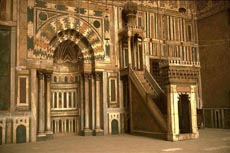 |
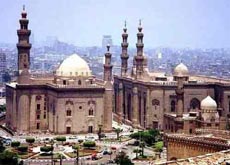 |
|
Muqarnas from the Sultan Hassan Mosque, Cairo |
| |
|
An Islamic invention of the 10th century, the muqarnas,
another three dimensional design, was not really
widespread until the 12th century, yet it is certainly one
of the most aesthetically interesting forms of decoration.
In effect, this is a highly sophisticated application of
geometric principles, really often an extension of two
dimensional design, that incorporates a replication of
units arranged in rows corbelled one atop another.
muqarnas configurations are therefore arranged according
to recilinear, or radial grids in which the circles and
its polygonal and star shaped extensions are basic
features, just as in early arabesque, only with
stereometric extensions.
The units themselves may be made of wood, stone, stucco or
ceramics, and can be arranged to fit within any
configuration and to visually dematerialize and divide
surfaces, and so they may often be found in a variety of
structures, including column capitals, minaret balconies,
cornices and entrance portals. While in rare cases, these
elements may have structural value, most often they are
purely decorative.
In specific monuments, such as the Mosque of Sultan Hasan
in Cairo, the use of muqarnas may be very general,
covering much of the monument, while in specific styles,
such as that of the Ottoman mosques, it may be limited,
but a standard feature of certain elements, such as the
portal, mihrab, column capitals and minaret balconies.
|
|